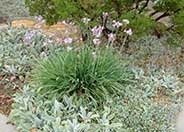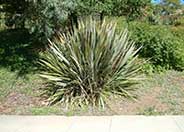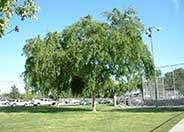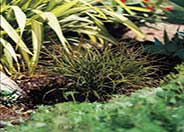
Common name:Society Garlic
Botanical name:Tulbaghia violacea
This clumping perennial will grow less than 1' tall and has narrow, blue green leaves. Clusters of lavender flowers bloom in spring and summer. Leaves and flowers have a distinct onion or garlic smell if crushed.

Common name:Blue Fescue
Botanical name:Festuca glauca
This ground cover/grass will grow less than 1' tall and has small, blue green leaves.
Maintenance Tips
Festuca glauca is a perennial clump-forming grass. It has soft straw-like leaves that form a blue-green dome that can get up to about 10 inches wide and tall. They prefer full sun and well-drained soil, but can tolerate slight shade, drought conditions, and poor soil nutrition. These will send out flower stalks in the summer, which should be cut back to the base after a few months to give them a cleaner appearance. They will also benefit from having any dead leaves pulled from the plant at any time of year, but the fall is typically the best time to clean up the foliage. It is short-lived in the landscape, with a lifespan of about 2-4 years after which it dies out in the center. Some might dig up and divide the living edges into several new plants, but most of the time it is easier to replace with a new one.
Common name:Butterfly-Iris, Fortnight Lily
Botanical name:Dietes iridioides
This clumping evergreen Iris bears tall, narrow leaves to 30" tall and white flowers marked purple in the center on stalks up to 3' tall. This variety has stiffer, darker foliage than the bicolor form. It requires sun to part shade with little or no summer watering when established.

Common name:New Zealand Flax
Botanical name:Phormium tenax
New Zealand Flax is a large, bold plant with stiffly vertical, sword-like, green leaves that arise from its base. It should be grown under full sun for best color. Varieties will offer different growth habits and leaf color.
Maintenance Tips
Phormium tenax is a perennial that grows as a clump with strap-like leaves. This is a very popular plant and has many different hybrids that are selected for their different foliage colors, sizes, and textures. When growing this species, there is a lot of genetic variety, so the size of the mature plant can range from 2' up to 8'. To keep the maintenance as low as possible, plant in a location that is full sun, and well-drained and give it the space it needs to reach maturity. These plants are often the victim of poor pruning habits, with gardeners cutting the leaves off in the middle or shearing them because they are too large for the space they have been given. If this is the case, they should be transplanted to a location where they can reach their full size, or other plants around them should be moved out of their way.
Common name:Chinese or Evergreen Elm
Botanical name:Ulmus parvifolia
This evergreen tree will grow about 40'-60' tall and 50'-70' wide. It has leathery, dark green leaves and round fruit in the fall.

Common name:Boston Ivy
Botanical name:Parthenocissus tricuspidata
This deciduous vine grows leaves that are usually lobed and divided into 3 leaflets. It clings tightly to any surface.

Common name:Tom Thumb Flax
Botanical name:Phormium 'Tom Thumb'
Tom Thumb Flax is an excellent accent plant for the garden. Evergreen leaves are long, narrow, and grow upright. Clusters of flowers grow on spikes above the foliage in late spring and summer. 'Tom Thumb' is the greenest variety, with very narrow, red bronze edges on the leaves. Leaves are small, and plant grows to 18" tall.
Photographer: GardenSoft
Physical weed control, including mulching, or hand removal protects the watershed from harmful chemicals.
Mulching and adding compost to soil can minimize evaporation and help soil absorb and store water.
Attract, or buy beneficial insects such as ladybugs and lacewings to control pest outbreaks in your garden.